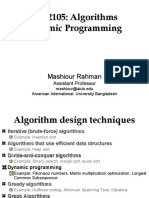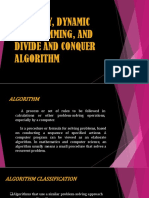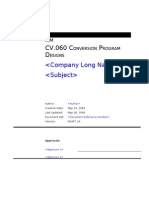Algorithms Lecture
Uploaded by
Ruba NiaziAlgorithms Lecture
Uploaded by
Ruba NiaziCS5613- Advanced Analysis of Algorithms MS(CS) - MAJU
Lecture 5
DYNAMIC PROGRAMMING
Dynamic Programming is a general algorithm design technique for solving problems
defined by or formulated as recurrences with overlapping sub instances.
Invented by American mathematician Richard Bellman in the 1950s to solve optimization
problems and later assimilated by CS
“Programming” here means “planning”
Main idea:
o Set up a recurrence relating a solution to a larger instance to solutions of some
smaller instances
o Solve smaller instances once
o Record solutions in a table
o Extract solution to the initial instance from that table
Dynamic Programming is an algorithm design technique for optimization problems: often
minimizing or maximizing.
Dynamic Programming and memorization work together.
Like divide and conquer, DP solves problems by combining solutions to subproblems.
Unlike divide and conquer, subproblems are not independent.
» Subproblems may share subproblems,
» However, solution to one subproblem may not affect the solutions to other subproblems
of the same problem.
Major components of DP
Recursion: Solves problem recursively.
Memorization: To store the result of already solved problems.
In General DP=Recursion + Memorization
Prepared by: Engr. M. Nadeem Page 1
CS5613- Advanced Analysis of Algorithms MS(CS) - MAJU
Comparison with divide-and-conquer Algorithm
Divide-and-conquer algorithms split a problem into separate subproblems, solve the
subproblems, and combine the results for a solution to the original problem
o Example: Quicksort
o Example: Mergesort
o Example: Binary search
Divide-and-conquer algorithms can be thought of as top-down algorithms
In contrast, a dynamic programming algorithm proceeds by solving small problems, then
combining them to find the solution to larger problems
Dynamic programming can be thought of as bottom-up
Comparison with greedy Algorithm
Greedy technique focuses on expanding partially constructed solutions until you arrive at a
solution for a complete problem. It is then said, it must be "the best local choice among all
feasible choices available on that step".
Optimal substructure means that you can greedily solve subproblems and combine the solutions
to solve the larger problem. The difference between dynamic programming and greedy
algorithms is that with dynamic programming, there are overlapping subproblems, and
those subproblems are solved using memoization. "Memoization" is the technique whereby
solutions to subproblems are used to solve other subproblems more quickly.
Prepared by: Engr. M. Nadeem Page 2
CS5613- Advanced Analysis of Algorithms MS(CS) - MAJU
Example:
Prepared by: Engr. M. Nadeem Page 3
CS5613- Advanced Analysis of Algorithms MS(CS) - MAJU
Prepared by: Engr. M. Nadeem Page 4
CS5613- Advanced Analysis of Algorithms MS(CS) - MAJU
Dynamic Programming Algorithms:
1. Longest Common Subsequence Problem
2. 0/1 Knapsack Problem
3. Coin Changing Problem
Advantages of Dynamic programming:
A recursive procedure does not have memory
Dynamic programming stores previous values to avoid multiple calculations
Prepared by: Engr. M. Nadeem Page 5
You might also like
- The Age of AI and Our Human Future (Henry Kissinger, Eric Schmidt Etc.) (Z-Library)100% (8)The Age of AI and Our Human Future (Henry Kissinger, Eric Schmidt Etc.) (Z-Library)148 pages
- Christopher Langan - CTMU, The Cognitive-Theoretic Model of The Universe, A New Kind of Reality Theory88% (8)Christopher Langan - CTMU, The Cognitive-Theoretic Model of The Universe, A New Kind of Reality Theory56 pages
- Data Structure and Algorithmic Thinking With Python Data Structure and Algorithmic Puzzles PDF95% (20)Data Structure and Algorithmic Thinking With Python Data Structure and Algorithmic Puzzles PDF471 pages
- Gayle Laakmann McDowell - Cracking The Coding Interview - 189 Programming Questions and Solutions (2015, CareerCup)81% (48)Gayle Laakmann McDowell - Cracking The Coding Interview - 189 Programming Questions and Solutions (2015, CareerCup)708 pages
- Gödel, Escher, Bach - An Eternal Golden Braid (20th Anniversary Edition) by Douglas R. Hofstadter (Charm-Quark) PDF100% (10)Gödel, Escher, Bach - An Eternal Golden Braid (20th Anniversary Edition) by Douglas R. Hofstadter (Charm-Quark) PDF821 pages
- Cracking The Coding Interview - 189 Programming Questions and Solutions (6th Edition) (EnglishOnlineClub - Com)100% (10)Cracking The Coding Interview - 189 Programming Questions and Solutions (6th Edition) (EnglishOnlineClub - Com)708 pages
- Chris Bailey - Hyperfocus - The New Science of Attention, Productivity, and Creativity-Viking (2018)100% (25)Chris Bailey - Hyperfocus - The New Science of Attention, Productivity, and Creativity-Viking (2018)306 pages
- The Art of Asking ChatGPT For High-Quality Answers A Complete Guide To Prompt Engineering Techniques (Ibrahim John) (Z-Library)100% (24)The Art of Asking ChatGPT For High-Quality Answers A Complete Guide To Prompt Engineering Techniques (Ibrahim John) (Z-Library)52 pages
- Advanced Materials Management - InstructorNo ratings yetAdvanced Materials Management - Instructor46 pages
- Cs 229, Autumn 2016 Problem Set #2: Naive Bayes, SVMS, and TheoryNo ratings yetCs 229, Autumn 2016 Problem Set #2: Naive Bayes, SVMS, and Theory20 pages
- Unit-Iii (Part-2) Dynamic ProgrogrammingNo ratings yetUnit-Iii (Part-2) Dynamic Progrogramming42 pages
- Analysis_and_Application_of_Dynamic_ProgrammingNo ratings yetAnalysis_and_Application_of_Dynamic_Programming5 pages
- Dynamic-Programming.pptx_20241230_132508_0000No ratings yetDynamic-Programming.pptx_20241230_132508_00008 pages
- A Survey of Dynamic Programming AlgorithmsNo ratings yetA Survey of Dynamic Programming Algorithms7 pages
- Characterizing Dynamic Programming: R. InkuluNo ratings yetCharacterizing Dynamic Programming: R. Inkulu17 pages
- Dynamic Programming: by Dr.V.Venkateswara RaoNo ratings yetDynamic Programming: by Dr.V.Venkateswara Rao23 pages
- Dynamic Programming Presentation (Autosaved)No ratings yetDynamic Programming Presentation (Autosaved)17 pages
- Design and Analysis of Algorithm Assignment # 01No ratings yetDesign and Analysis of Algorithm Assignment # 019 pages
- Greedy, Dynamic Programming, and Divide and Conquer AlgorithmNo ratings yetGreedy, Dynamic Programming, and Divide and Conquer Algorithm15 pages
- Dynamic Programming - Set 1 (Overlapping Subproblems Property) - GeeksforGeeks PDFNo ratings yetDynamic Programming - Set 1 (Overlapping Subproblems Property) - GeeksforGeeks PDF5 pages
- Introduction To Analysis of Algorithms: Al-KhowarizmiNo ratings yetIntroduction To Analysis of Algorithms: Al-Khowarizmi11 pages
- Topic Wise MCQ of Artificial Intelligence (A.i)67% (3)Topic Wise MCQ of Artificial Intelligence (A.i)87 pages
- Roadmap How To Learn AI in 2024 (Uncovered AI)No ratings yetRoadmap How To Learn AI in 2024 (Uncovered AI)6 pages
- Python Programming and Maching Learning 2 in 1 B08Y5DPX32100% (7)Python Programming and Maching Learning 2 in 1 B08Y5DPX32145 pages
- Current and Future Trends on AI Applications - Mohammed A Al-SharafiNo ratings yetCurrent and Future Trends on AI Applications - Mohammed A Al-Sharafi456 pages
- FIN3160 Seminar Solution Analysis of BetaNo ratings yetFIN3160 Seminar Solution Analysis of Beta2 pages
- Direction: MULTIPLE CHOICE .Choose The Letter of The Correct AnswerNo ratings yetDirection: MULTIPLE CHOICE .Choose The Letter of The Correct Answer2 pages
- Maria Fadiman: Ethnobotanist: Reading CommunicationNo ratings yetMaria Fadiman: Ethnobotanist: Reading Communication1 page
- Social Media in The Philippines Is Widesprea1No ratings yetSocial Media in The Philippines Is Widesprea11 page
- 2024 Diagram - New Updates Chartered Engineer ProcessNo ratings yet2024 Diagram - New Updates Chartered Engineer Process1 page
- Analisis Pembelajaran Siswa Materi Menyimak Teks Berita Pada Kelas Vii SMP Negeri 2 PontianakNo ratings yetAnalisis Pembelajaran Siswa Materi Menyimak Teks Berita Pada Kelas Vii SMP Negeri 2 Pontianak9 pages























































































































